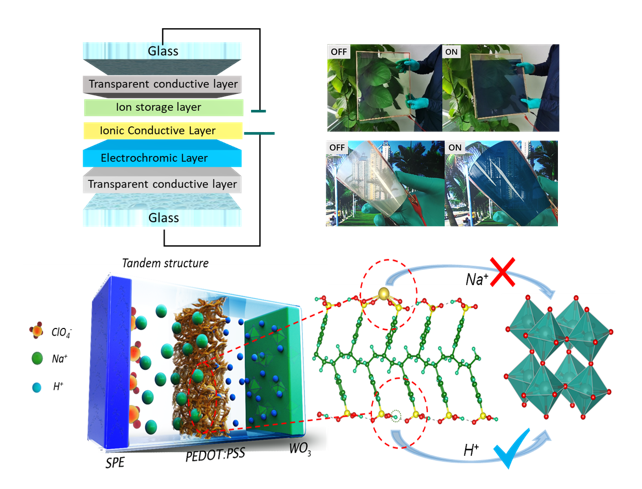
Dynamic Windows and Devices
· Thermochromic VO2:
Energy-efficient applications: Propose optical structure design and optimization of optical performance, develop several kinds of high-performance of VO2-based thermochromic smart windows (Eg. Cr2O3/VO2/SiO2/Glass, SiNx/VO2/SiNx/Glass). Improve the critical optical properties (High luminous transmittance and Solar energy modulation). Meanwhile, based on the multifunctional structures, realize the combination of low-temperature fabrication, environmental stability and self-cleaning functions.

Phase-transition Modulation, Mechanism of VO2 and Novel Device Integration: Phase-transition Modulation, Mechanism of VO2 and Novel Device Integration. Construct new multi-field regulation modes of VO2 based-phase-transition structure. Utilize electrochromic, optical chromic materials (Eg. HxWO3、YHx) for realizing the control of defect (ion or charge) trapping and detrapping in VO2 thin films. Investigate the mechanism of phase-transition and modulation behaviors in the strongly correlated electron systems.

· Electrochromic Materials and Devices:
Highly Efficient Inorganic Electrochromic Design and Ion Transport Mechanism: Electrochromic smart windows are a recent technology which can notably reduce the building energy consumption via the dynamic and independent control of near-infrared and visible light transmittance. Based on the design of inorganic electrochromic material (cathode), cation storage layer, counter electrode (anode), and transparent electrodes, highly efficient electrochromic devices are designed. Furthermore, multi-functional EC devices, such as wide-spectrum adjustment (VIS/ IR dual control), energy storage, bistable state, etc., with high-efficiency are also studied.
Recently we designed an all-solid-state tandem structure of SPE/PEDOT:PSS/WO3, which creates a relay process of Na+ and protons in the PEDOT:PSS layer: that is, Na ions from the SPE layerare used to pump more protons from PEDOT:PSS to WO3. ECDs can achieve ultrafast responses (colouration to 90% in 0.7 s and bleaching to 65% in 0.9 s and 90% in 7.1 s), high contrast ratios (about 90%), good CE (109 cm2 C-1 at 670 nm) and excellent cycling stability. (Nature Electronics 5, 45-52, 2022).

· Other Chromogenic Materials:
High-performance photochromic (ReOxHy) , gas-chromic (Mg-Ni alloys) and even piezochromic materials and devices are also investigated in our lab.

